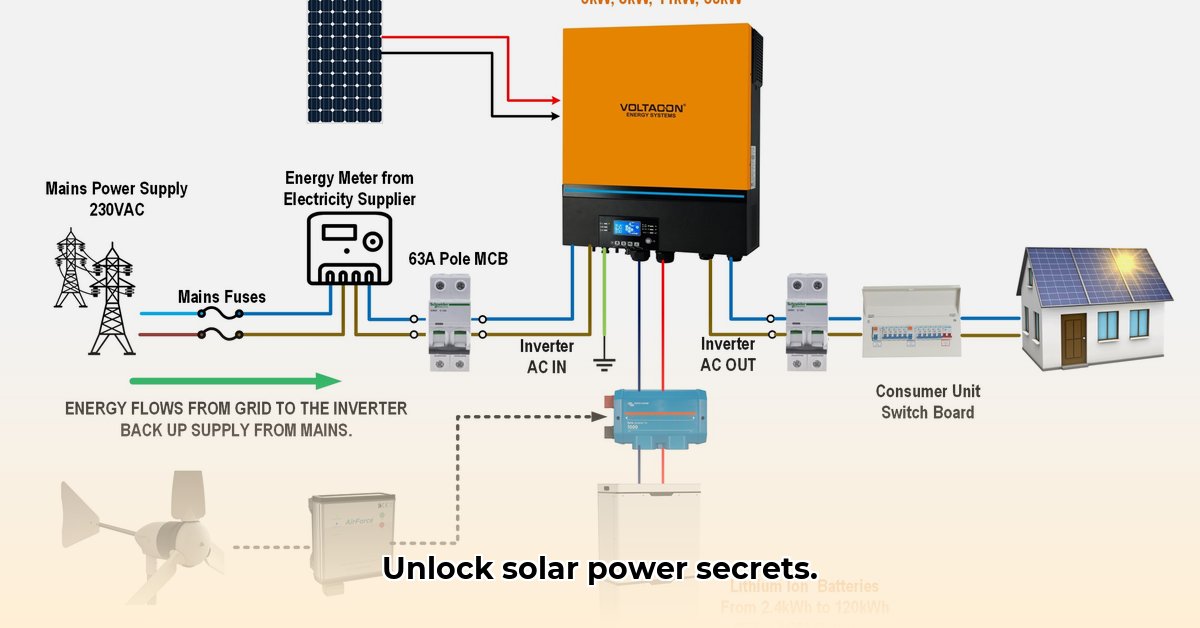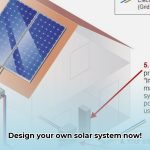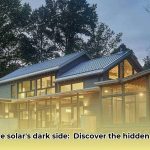Thinking about solar power for your home or business? It’s more accessible than you might think! This comprehensive guide will walk you through everything you need to know, from understanding the fundamental principles to conceptualizing your own system. We’ll dissect the various components of a solar system using clear and concise language, illustrate their interconnected functionality, and provide assistance in determining the appropriate system size for your specific requirements. Furthermore, we will address the critical aspects of safe setup, continuous operational efficiency, and effective troubleshooting techniques for resolving any potential issues. Regardless of whether you’re a novice or possess existing knowledge of solar technology, this guide will empower you to effectively harness the limitless potential of solar energy. For a visual representation, check out this solar energy diagram.
Solar Energy System Diagram Basics: Unlocking the Sun’s Power
Let’s delve into the intricacies of solar energy! This guide explores solar energy system diagrams, transitioning you from basic concepts to a sophisticated understanding of how these systems operate, emphasizing energy efficient solutions. We’ll prioritize clear language, avoiding technical jargon, enabling you to grasp the fundamentals of renewable energy generation.
Key Components: The Players in Your Solar Power Team
Envision a solar power system as a coordinated team, working in harmony to deliver clean energy to your home or commercial building. Each component plays a crucial role in energy conversion and distribution.
-
Solar Panels (The Energy Collectors): These are the primary energy converters, directly transforming sunlight into electricity. Visualize them as constantly recharging solar batteries, drawing power from the sun. They consist of photovoltaic (PV) cells—specialized semiconductors that convert light into electricity. High-efficiency panels maximize light absorption.
-
Charge Controller (The Traffic Manager): This pivotal device regulates the electrical current flowing from the solar panels to the batteries (if your system includes them). Functioning like a smart traffic director, it optimizes the charging process and prevents overcharging, thereby protecting your batteries from potential damage and ensuring prolonged battery life.
-
Inverter (The Power Translator): Solar panels generate direct current (DC) electricity, while most homes and businesses rely on alternating current (AC) electricity. The inverter serves as the essential translator, converting DC power into AC power that can be used to power lights, appliances, and other electronic devices. High-quality inverters minimize energy loss during conversion.
-
Batteries (Optional, but Often a Smart Move): Batteries store surplus solar energy generated by your panels. This is particularly beneficial for completely off-grid systems or for maintaining power availability during periods of low sunlight. Think of them as a backup power reservoir, ensuring uninterrupted power supply even when the sun is not shining. Batteries are not always required. Their necessity is dependent on system demands and financial considerations. Lithium-ion batteries offer superior performance and lifespan compared to traditional lead-acid batteries.
System Types: Choosing Your Solar Power Style
There are three primary configurations of solar power systems, each characterized by distinct advantages and disadvantages. A comprehensive understanding of these differences will enable you to select the system that best caters to your specific needs for home energy solutions.
-
On-Grid Systems (Connected to the Main Grid): These systems are the most prevalent and frequently the most economical. They maintain a connection to the local power grid. When your solar panels generate more electricity than you are consuming, the excess power is typically fed back into the grid. Net metering programs may allow you to receive credits on your electricity bill for this surplus energy. However, this system will cease operation during grid outages.
-
Off-Grid Systems (Completely Independent): These systems operate autonomously, completely isolated from the utility grid, offering energy independence. This configuration necessitates reliance on both solar energy and battery storage. While this approach provides energy independence, it entails a higher initial investment and necessitates a larger battery bank to ensure continuous power supply, especially during nighttime or periods of reduced sunlight.
-
Hybrid Systems (The Best of Both Worlds): These systems synthesize the advantages of on-grid and off-grid configurations. They maintain a grid connection while incorporating batteries to store excess solar energy. This provides backup power during grid interruptions and the flexibility to utilize solar energy even under diminished sunlight conditions. Smart hybrid systems can optimize energy usage based on grid conditions and energy prices.
Here’s a detailed comparison table:
| System Type | Grid Connection | Battery Storage | Pros | Cons |
|---|---|---|---|---|
| On-Grid | Yes | Usually No | Cost-effective, straightforward installation, potential for net metering, reduces reliance on fossil fuels, environmentally friendly. | No power during grid outages, limited energy independence, subject to grid regulations, may require grid upgrades. |
| Off-Grid | No | Yes | Energy independence, power availability during grid outages, suitable for remote locations, reduced carbon footprint, long-term savings. | High upfront cost, necessitates substantial battery storage, requires regular maintenance, susceptible to weather conditions. |
| Hybrid | Yes | Yes | Backup power during outages, increased energy independence, optimized energy usage, grid support, reduced electricity bills. | Higher initial cost compared to on-grid, more complex installation, requires battery maintenance, system design must match energy needs. |
System Sizing and Design: Powering Your Life
Determining the optimal size for your solar system requires careful consideration of several key factors. Similar to selecting the appropriate engine size for a vehicle, you need adequate power without excess capacity for solar power optimization. Take into account the following:
-
Your Energy Use: Determine your daily electricity consumption. Review your electricity bills to ascertain your average usage, typically expressed in kilowatt-hours (kWh). Smart meters provide detailed insights into energy consumption patterns.
-
Sunlight Availability: Assess the solar irradiance levels at your location. The amount of sunlight your home receives directly impacts the amount of electricity your system can generate. Consult solar irradiance maps and local weather data.
-
Roof Conditions: Analyze your roof’s orientation (south-facing orientation is generally optimal in the Northern Hemisphere), angle, and any shading caused by trees or adjacent structures. All these factors influence the overall efficiency of the system. Optimize roof angle for maximum sunlight capture.
Professional solar installers possess specialized software and expertise to design a customized system that aligns precisely with your energy requirements and site-specific conditions. Recognizing the significance of professional assessments is vital for attaining enhanced energy efficiency and long-term performance.
Installation and Safety: Leave it to the Pros
Installation of a solar power system necessitates working with direct current (DC) electricity, which can present hazards if mishandled. Engaging a qualified and experienced installer is paramount to ensure the system is installed correctly and safely. Substandard installation can lead to substantial problems, ranging from electrical hazards to system malfunctions, safety hazards, and property damage. It simply is not a DIY activity. Professional installers ensure compliance with electrical codes and safety standards.
Maintenance and Troubleshooting: Keeping Your System Running Smoothly
Like all technical systems, your solar power setup requires periodic maintenance. Consistent monitoring and cleaning of the solar panels will enhance their lifespan, ensure dependable performance, and maximize energy production. Observe the system’s performance metrics and promptly address any anomalies. Simple troubleshooting steps can resolve minor issues, but complex problems necessitate professional servicing. It’s advisable to entrust most maintenance and repair tasks to qualified professionals. Regular inspections can identify potential problems before they escalate.
Conclusion: Embracing the Power of the Sun
A carefully designed solar energy system, facilitated by a thorough understanding of its diagram, can pave the way to a more environmentally conscious and potentially more cost-effective energy future. With several system designs available, understanding the components, system types, and safety measures will ensure you confidently embark on this transition. Always seek guidance from qualified professionals for installation and complex repairs. Solar power adoption significantly reduces environmental impact and promotes sustainability.
How to Compare Different Home Solar Panel Inverter Technologies for Efficiency
Let’s dive into the heart of your solar system: the inverter. It’s the crucial component that transforms the direct current (DC) electricity generated by your solar panels into the alternating current (AC) electricity your home uses. But with various inverter types available – string, micro, hybrid, and off-grid – choosing the right one can feel overwhelming. This guide will help you navigate the options and make the best decision for your needs for home energy solutions.
Understanding Solar Inverter Types
-
String Inverters: These are the most common and budget-friendly option. A single string inverter handles the power output from a series of solar panels. They are simple to install but have a major drawback: if one panel is shaded, the entire string’s output decreases. Think of it like a single light switch controlling a row of lights – if one bulb goes out, they all dim. Advanced string inverters with optimizers mitigate some shading losses.
-
Microinverters: Each solar panel has its own microinverter, converting DC to AC individually. This means if one panel is shaded, the others continue to produce power at full capacity. This is like having a separate switch for each light bulb – if one bulb burns out, the others stay on. The improved performance comes at a higher upfront cost. Microinverters also offer panel-level monitoring.
-
Hybrid Inverters: These combine the functions of a solar inverter and a battery charger/inverter. They offer the ability to store excess solar energy in batteries for later use, providing backup power during outages and maximizing self-sufficiency. They are ideal for off-grid living and increasing energy independence. Consider this as a powerful,
- Hydro Extrusions USA Leads North American Aluminum Profile Solutions - December 28, 2025
- Hydro North America Leads Aluminum Extrusion Solutions Across Diverse Industries - December 27, 2025
- Hydro Extrusion North America Provides Custom Solutions Across Diverse - December 26, 2025
















